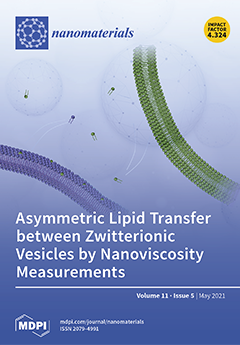Pristine, and In-, Sn-, and (In, Sn)-doped Bi
2Se
3 nanoplatelets synthesized on Al
2O
3(100) substrate by a vapor–solid mechanism in thermal CVD process via at 600 °C under 2 × 10
−2 Torr. XRD and HRTEM reveal that
[...] Read more.
Pristine, and In-, Sn-, and (In, Sn)-doped Bi
2Se
3 nanoplatelets synthesized on Al
2O
3(100) substrate by a vapor–solid mechanism in thermal CVD process via at 600 °C under 2 × 10
−2 Torr. XRD and HRTEM reveal that In or Sn dopants had no effect on the crystal structure of the synthesized rhombohedral-Bi
2Se
3. FPA–FTIR reveals that the optical bandgap of doped Bi
2Se
3 was 26.3%, 34.1%, and 43.7% lower than pristine Bi
2Se
3. XRD, FESEM–EDS, Raman spectroscopy, and XPS confirm defects (
), (
), (
), (
), and (
). Photocurrent that was generated in (In,Sn)-doped Bi
2Se
3 under UV(8 W) and red (5 W) light revealed stable photocurrents of 5.20 × 10
−10 and 0.35 × 10
−10 A and high I
photo/I
dark ratios of 30.7 and 52.2. The rise and fall times of the photocurrent under UV light were 4.1 × 10
−2 and 6.6 × 10
−2 s. Under UV light, (In,Sn)-dopedBi
2Se
3 had 15.3% longer photocurrent decay time and 22.6% shorter rise time than pristine Bi
2Se
3, indicating that (In,Sn)-doped Bi
2Se
3 exhibited good surface conduction and greater photosensitivity. These results suggest that In, Sn, or both dopants enhance photodetection of pristine Bi
2Se
3 under UV and red light. The findings also suggest that type of defect is a more important factor than optical bandgap in determining photo-detection sensitivity. (In,Sn)-doped Bi
2Se
3 has greater potential than undoped Bi
2Se
3 for use in UV and red-light photodetectors.
Full article






